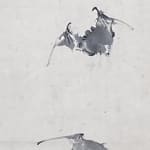




Kamo Suetaka
Two Bats, 1820s
Sumi Ink on Paper
37 3/4” x 9” ; scroll, 68” x 10”
$ 3,500.00
Further images
In Japanese painting, bats often appeared with a moon. Instead of painting a moon, Suetaka presents a poem referring to the moon in its place. He seamlessly combines poetry and...
In Japanese painting, bats often appeared with a moon. Instead of painting a moon, Suetaka presents a poem referring to the moon in its place. He seamlessly combines poetry and painting to record a precise moment of the evening and his state of mind.
The poem reads:
Higure Gusa
Nani Kawahori Zo
Tsuki Machi Te
Atsusa
Wasururu
Natsu No Yugure
It translates to:
“summer evening
hikege-gusa (plant) is blooming.
bats are waiting for the moon
we can forget the summer heat for a while”
With minimal brushstrokes, the artist captures two bats in flight, suggesting their jagged and unpredictable movements from an instance. Suetaka transports us to this summer night, allowing us to share the experience over a century later and appreciate his fleeting thoughts.
About Artist:
Suetaka Kamo (1754 - 1841) was a priest of Shinto religion at Kamo shrine in Kyoto. His family was serving to the shrine, too. When he was very young, he was sent to serve prince Arisugawa. Serving the prince, who was an avid and excellent poet in Waka form ( a 31-syllable poem), he learned poetry well and established the foundation to become a poet himself, and later he became an excellent one. He also learned Kokugaku, a school of philosophy to learn ancient Japanese aesthetics, culture, and thoughts and to encourage its followers to go back to the fundamentals of “Japanese-ness.” He became one of its leading scholars as well as artists.
Japanese culture has been repeating one period when it is accepting the culture from others, and another period when it is modifying what it has accepted. Kokugaku philosophy arose when Japanese culture was modifying the Chinese Shushi-philosophy and Buddhism that came to Japan before.
The poem reads:
Higure Gusa
Nani Kawahori Zo
Tsuki Machi Te
Atsusa
Wasururu
Natsu No Yugure
It translates to:
“summer evening
hikege-gusa (plant) is blooming.
bats are waiting for the moon
we can forget the summer heat for a while”
With minimal brushstrokes, the artist captures two bats in flight, suggesting their jagged and unpredictable movements from an instance. Suetaka transports us to this summer night, allowing us to share the experience over a century later and appreciate his fleeting thoughts.
About Artist:
Suetaka Kamo (1754 - 1841) was a priest of Shinto religion at Kamo shrine in Kyoto. His family was serving to the shrine, too. When he was very young, he was sent to serve prince Arisugawa. Serving the prince, who was an avid and excellent poet in Waka form ( a 31-syllable poem), he learned poetry well and established the foundation to become a poet himself, and later he became an excellent one. He also learned Kokugaku, a school of philosophy to learn ancient Japanese aesthetics, culture, and thoughts and to encourage its followers to go back to the fundamentals of “Japanese-ness.” He became one of its leading scholars as well as artists.
Japanese culture has been repeating one period when it is accepting the culture from others, and another period when it is modifying what it has accepted. Kokugaku philosophy arose when Japanese culture was modifying the Chinese Shushi-philosophy and Buddhism that came to Japan before.
Signup for our Newsletter
You will receive two emails a month from us. One introduces artworks and design works from Kyoto's hidden sources and the other is stories from Misako, sharing insights into Japanese culture.
* denotes required fields
为了回应您的查询,我们将根据我们的隐私政策处理您提供的个人数据。




